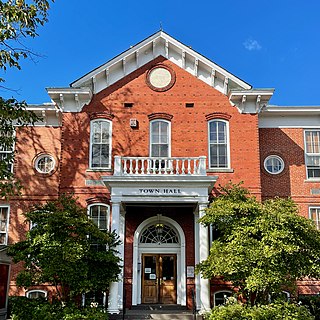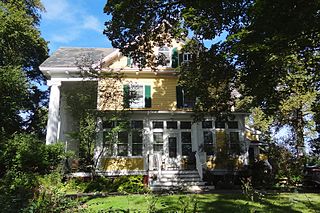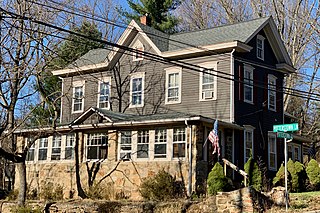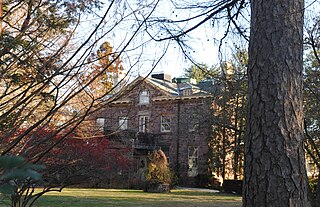
Cranbury is a township in southern Middlesex County, within the U.S. state of New Jersey. Located within the heart of the Raritan Valley region, Cranbury is roughly equidistant between New York City and Philadelphia, contributing to it being a regional historical, cultural, and commercial hub of Central New Jersey and as an outer-ring commuter suburb of New York City within the New York metropolitan area. The municipal taxes generated by the industrial properties have helped to keep residential property taxes steady over time. As of the 2020 United States census, the township's population was 3,842, a decrease of 15 (−0.4%) from the 2010 census count of 3,857, which in turn had reflected an increase of 630 (+19.5%) from the 3,227 counted at the 2000 census.

East Brunswick is a township in Middlesex County, in the U.S. state of New Jersey. The suburban bedroom community is part of the New York City metropolitan area and is located on the southern shore of the Raritan River, directly adjacent to the city of New Brunswick and located roughly 29 miles (47 km) away from New York City. As of the 2020 United States census, the township's population was 49,715, its highest decennial count ever and an increase of 2,203 (+4.6%) from the 2010 census count of 47,512, which in turn reflected an increase of 756 (+1.6%) from the 46,756 counted in the 2000 census.

Highland Park is a borough in Middlesex County, in the U.S. state of New Jersey, in the New York City metropolitan area. The borough is located on the northern banks of the Raritan River, in the Raritan Valley region. As of the 2020 United States census, the borough's population was 15,072, an increase of 1,090 (+7.8%) from the 2010 census count of 13,982, which in turn reflected a decline of 17 (−0.1%) from the 13,999 counted in the 2000 census.

New Brunswick is a city in and the seat of government of Middlesex County, in the U.S. state of New Jersey. A regional commercial hub for central New Jersey, the city is both a college town and a commuter town for residents commuting to New York City within the New York metropolitan area. New Brunswick is on the Northeast Corridor rail line, 27 miles (43 km) southwest of Manhattan. The city is located on the southern banks of the Raritan River in the heart of the Raritan Valley region.

South Brunswick is a township in Middlesex County, in the U.S. state of New Jersey. The township is centrally located within the Raritan Valley region and is an outer-ring suburb of New York City in the New York metropolitan area. As of the 2020 United States census, the township's population was 47,043, its highest ever decennial census count and an increase of 3,626 (+8.4%) from the 2010 census count of 43,417, which in turn reflected an increase of 5,683 (+15.1%) from the 37,734 counted in the 2000 census.

Chesterfield, originally known as Recklesstown, is an unincorporated community located around the intersection of County Route 528 and County Route 677 in Chesterfield Township of Burlington County, New Jersey.

The Henry Guest House is in New Brunswick, Middlesex County, New Jersey, at Livingston Avenue and Morris Street. It was originally located on New Street between Livingston Avenue and George Street. The Georgian stone farmhouse was built in 1760 by Henry Guest. He was a New Brunswick alderman and an associate of John Adams and author Thomas Paine. It was added to the National Register of Historic Places on May 24, 1976.

Old Queens is the oldest extant building at Rutgers University and is the symbolic heart of the university's campus in New Brunswick in Middlesex County, New Jersey in the United States. Rutgers, the eighth-oldest college in the United States, was founded in 1766 during the American colonial period as Queen's College. Queen's College was named for Charlotte of Mecklenburg-Strelitz, the daughter of a German duke who became the queen consort of British king George III. Old Queens is located on a six-acre hilltop city block bounded by Somerset Street, Hamilton Street, College Avenue and George Street that was previously an apple orchard. Donated to the college in 1807 by James Parker, Jr., this city block become known the Queen's Campus and is the historic core of the university. Because of this, by metonymy, the name "Old Queens" came to be used as a reference to Rutgers College and is often invoked as an allusive reference to the university or to its administration.

Potterstown is an unincorporated community along the border of Clinton and Readington townships in Hunterdon County, New Jersey.

William H. Johnson House, built c. 1872, is a historic house in New Brunswick, Middlesex County, New Jersey, United States.

The Old Eagle Tavern is a historic building located at 431, 433 South Broad Street at the corner of Ferry Street in Trenton, Mercer County, New Jersey. The building was built in 1765 by Robert Waln. The building operated as a tavern and hotel from 1765 to 1896. It was added to the National Register of Historic Places on November 3, 1972 for its architectural, commercial, and political significance. The building is also a contributing property of the Trenton Ferry Historic District, which was listed on June 26, 2013.

Red Maple Farm, also known as Gulick House, is a historic house and bed and breakfast located on Raymond Road west of the Monmouth Junction section of South Brunswick in Middlesex County, New Jersey. It was added to the National Register of Historic Places on July 3, 1979, for its significance in agriculture and architecture. In addition to the main house, a smoke house and barn contribute to the property.

Westons Mills or Westons Mill is an unincorporated community located along the border of East Brunswick and New Brunswick in Middlesex County, New Jersey, United States. It is the location of Westons Mill Pond.

The Kingston Mill Historic District is a 49-acre (20 ha) historic district in Kingston, New Jersey. It is roughly bounded by the Millstone, River, and Princeton-Kingston Roads in the townships of Princeton in Mercer County, South Brunswick in Middlesex County, and Franklin in Somerset County. It was added to the National Register of Historic Places on April 10, 1986 for its significance in engineering, exploration/settlement, industry, and transportation. The district includes 16 contributing buildings and 2 contributing structures.

The Livingston Avenue Historic District is a historic district located along Livingston Avenue between Hale and Morris Streets in New Brunswick, Middlesex County, New Jersey. The district was added to the National Register of Historic Places on February 16, 1996, for its significance in architecture, social history, and urban history from 1870 to 1929. It has 58 contributing buildings and 2 contributing sites, including the Willow Grove Cemetery, the Henry Guest House, and the New Brunswick Free Public Library.

Wood Lawn is a historic mansion located off Ryders Lane on the Douglass Campus of Rutgers University in the city of New Brunswick in Middlesex County, New Jersey. The house was added to the National Register of Historic Places on March 8, 1978, for its significance in architecture and education. It is currently used by the Eagleton Institute of Politics.

The Demarest House is a historic building at 542 George Street in New Brunswick, New Jersey on the campus of Rutgers University. It was documented by the Historic American Buildings Survey in 1960. The house was later added to the National Register of Historic Places on August 10, 1977 for its significance in architecture, education, and social history.

The Thomas I. Agnew House is a historic home in New Brunswick, Middlesex County, New Jersey. The house was added to the National Register of Historic Places on May 13, 1982, for its significance in architecture. Also known as the Agnew Mansion, it is one of two surviving Greek Revival style houses in the city.

Old Bridge, also known as the Historic Village of Old Bridge, is an unincorporated community located within East Brunswick in Middlesex County, in the U.S. state of New Jersey. It is on the South River, a tributary of the Raritan River. The community is named after the first bridge built here to cross the river, the South River Bridge. After other bridges were built crossing the river, it became known as the Old Bridge. The Old Bridge Historic District, encompassing much of the village, is listed on the state and national registers of historic places.

The Withington Estate, also known as the Heathcote Farm, is a 12.5-acre (5.1 ha) farmstead located on Spruce Lane near the Kingston section of South Brunswick in Middlesex County, New Jersey. The farm is adjacent to the Cook Natural Area and the Heathcote Brook. It was added to the National Register of Historic Places on September 27, 1984, for its significance in agriculture, architecture, landscape architecture and politics/government. In addition to the main residence, a stone barn and carriage house contribute to the property.























